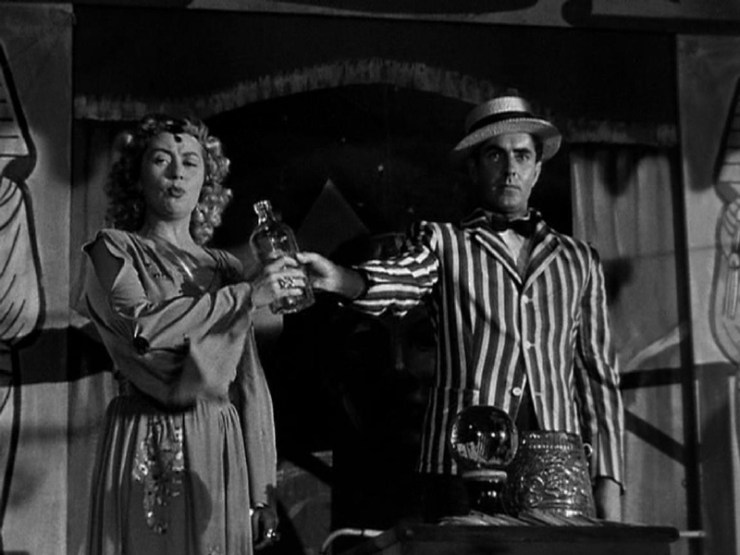The first adaptation of William Lindsay Gresham‘s 1946 novel is a bit of a genre-bending anomaly. Nightmare Alley featured a larger than usual budget for its type, a film noir that bleeds into other genres with a lead star intentionally playing against type. It centers around an unlikable protagonist haunted by his actions. Much of it is set against the backdrop of a carnival as complex as its lead. With Noirvember winding to a close and Guillermo del Toro‘s more faithful novel adaptation on the way, now makes for a perfect time to visit the 1947 gem.
Star Tyrone Power rose to fame in the ’30s and developed a reputation for playing romantic leads and swashbucklers, notably Zorro from The Mask of Zorro. Eventually, though, Power sought to break type and act outside of his usual wheelhouse. A fan of Gresham’s novel, Powers spent considerable effort convincing 20th Century Fox’s studio chief Darryl F. Zanuck to acquire rights and let him star as the unsavory Stanton Carlisle.

Nightmare Alley chronicles Stanton’s rise and fall as a con man, coming full circle in a seedy little traveling carnival. We meet Stan as the carnival barker, an outsider fascinated by this peculiar world, from the glitzy glamour of Electra to the pitiful geek, whom Stan deems inferior and low. Then Stanton sets his sights on Mademoiselle Zeena (Joan Blondell), a seer with one hell of a convincing act. Stan goes about wooing her, apprenticing her show, and learning her secrets for exploitive gain. One fatal accident and an uncovered love affair later, Stan’s exiled from the carnival. He uses Zeena’s trade secrets to create his own successful act in Chicago, catching the attention of a woman far more conniving and dangerous than he.
The hallmarks of film noir run through Nightmare Alley. The femme fatale, suspicion, and entrapment are all there in spades. Above all, it’s the fatalism that distinguishes this film as noir. Stan’s pursuit of fame and fortune gets underscored by his manipulative and often uncaring nature. He charms with ease but with a sense of superiority. Compared to the supporting characters, like the world-wearied Zeena or the kind-yet-naïve Molly (Coleen Gray), Stan’s a callous fool willing to use others to get ahead until it’s too late. He’s both likable and unlikable all at once.

The sole humanizing quality, outside of his relationship with Molly to an extent, is how haunted he gets by his own mistakes. A fatal error causes a death; Stan keeps it a secret, but it lingers like a ghost. His mistakes continue to compound and wear on him, dragging him to the depths of despair as he gives in to fear. There’s something haunting about the carnival, too, in the way many of the carnies are brow-beaten or realists; there’s no shiny American dream to achieve for them.
Director Edmund Goulding captures this highly complex world, highlighting all its beauty and ugliness simultaneously. The carnival and the affluent Chicago present a stark contrast, two very different playgrounds for Stanton to play his con game to diverging effects. These settings and the characters that inhabit them stretch the genre boundaries.
That Nightmare Alley was developed and released during the Hays Code era meant that screenwriter Jules Furthman needed to navigate the source material and extract the doom and pessimism without offending censors. In other words, this adaptation might be gorgeous and effective, but it didn’t reach the lows and darkness of the novel for poor Stanton.
That Guillermo del Toro’s adaptation seeks to be more faithful to Gresham’s novel likely means filling in the blanks that the 1947 film couldn’t. Regardless, 1947’s adaptation offers a unique glimpse at a bygone era of Hollywood and gave us a masterful performance by an actor purposefully seeking an unconventional part. Nightmare Alley‘s penchant for human darkness, deceit, and tragedy dabbles with drama and horror, just a tinge, offering an emotionally and visually complex gateway into film noir.